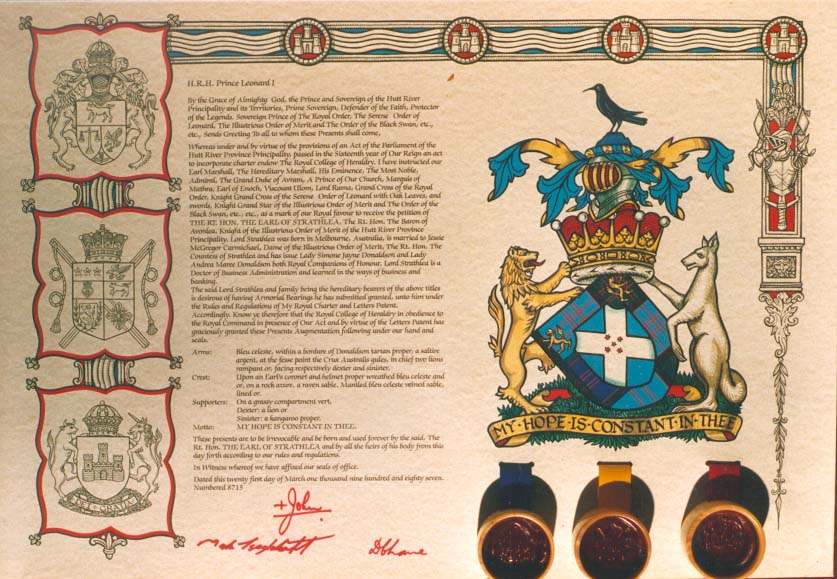|
THE ROYAL COLLEGE OF HERALDRY Current Royal Charter and Letters Patent issued 23/12/1986 - |
please click on the buttons below for further information |
| AIM The Royal College of Heraldry Certificates Available There are Three types of certificates available 1. A4 sheet on parchmentine approx 210 x 298 mm. 2. A3 sheet on parchmentine approx 298 x 420 mm. 3. Approx. 450 x 690 mm. as shown in the sample below. |

Further information on this historic and unique world wide College can be obtained by Emailing The Earl Marshall or clicking on the buttons above or below.
|
| The origin of heraldry
cannot be traced with certainty, yet it is clear that the adoption of
tribal,national,civic and personal badges began in prehistoric times. Heraldry is part of
our heritage. We still hanker after the pageantry of armour, fluttering pennons, gentle
knights and shields charged with armorial bearings.
Any individual who distinguishes himself may be said to ennoble himself. A Prince, judging an individual worthy of notice, gave him Letters Patent of nobility. In these letters were emblazoned the arms that were to distinguish his shield. By this shield he was to be known or ennobled. Hence arms are the criterion of nobility. Whoever has a shield of arms is a nobleman. It is not the exclusive realm of the aristocracy, the peerage, baronetage and knightage. It can be yours just for the asking. In every country of Europe, without exception, a grant of arms, of Letters Patent of nobility, is conferred on all descendants for posterity. The scholar values it for its historical and antiquarian interest; the artist and architect for its decorative qualities; the man of ancient family for the tradition it enshrines; the new made armiger (an esquire or any person possessing heraldic arms) for the attainment it represents. Its appeal is not limited to those who themselves possess armorial bearings. We all share in many loyalties and that heraldry symbolises, which interlock to form the social structure. It has long since ceased to be the prerogative of a class and can only be debased by snobbery. It is a matter of natural sentiment for a man to use that which his father had worthily borne and perhaps made famous. Often the shield alone, with its distinctive device, appeared on the seal which man used in his civil transactions; in effect, his heraldic shield became his signature. This is shown in various deed laws. Apart from sentiment, therefore, it is a matter of practical convenience for a son or daughter, on inheriting his or her responsibilities, to continue to use the seal-device which people had learned to associate with his or her forebears. Old arms will be recorded unaltered only to those in the direct line of descent from the original bearer, or those claiming to be of direct descent. We do not have the means to check all sources and authorities world-wide for arms or titles which may be claimed. For this reason any recording we make, is on the understanding that we accept in good faith the information supplied to us by the applicant, especially that his claim for arms is not an infringement of another's rights. We accept no responsibility if such an infringement should occur, that is the responsibility of the person making the claim for the recording of the arms or the heraldic device. In choice of arms, people follow their fancies, hopefully indicating their identity in a way which can be easily understood and remembered. Since arms are primarily a means of identification, they should be absolutely distinctive. They are personal to their owner and should provide historians with a knowledge of the individual. Hence its use as a precise method of personal identification. At the same time it is natural for people allied by blood or feudal ties to want similar arms. however a sufficiently differenced arms is required for registration. We invite you to petition Our beloved and worthy Earl Marshall for a grant of arms so that you may be ennobled.
|
||||
please click on the buttons below for further information |
||||
Postal Information: PO Box 628, Sorell, Tasmania, 7172. Phone: 61 3 62651007 Fax: 61 3 62651007 Web: www.grandduchy.org |
||||